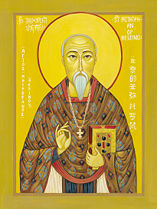Mitrophan Yang
Our righteous father, hieromartyr of the Yihetuan Movement (Boxer) Uprising, Mitrophan Ji was the first Chinese ordained a priest in the Church of China. He was one of the many martyrs of the Yihetuan Movement (Boxer) Uprising of 1900. He is commemorated on the feast day of the Chinese martyrs June 11.
Life
Mitrophan was born, probably in Beijing, on January 17, 1856 into a family of Chinese Orthodox associated with Russian Orthodox Mission in China. In Chinese, his name at birth was Yang Ji. He was given the Christian name of Mitrophan. His father died while he was very young, and he was raised by his mother Marina, who was a teacher at a school for girls, and his grandmother Ekaterina. Yang Ji grew to be a humble person who was cautious and quiet. He was peaceful in demeanor and was impassioned even when faced with great insults.
In 1864, when Archimandrite Pallady returned to lead the Russian Orthodox Mission for a second time, he charged Yang Ji’s teacher Juren Long Yuan with taking care of Yang Ji’s education so as to prepare him for ordination. Although urged by both Archimandrite Pallady and his teacher Long Yuan, Mitrophan was reluctant to accept ordination and constantly refused it noting “how can a person with insufficient abilities and charity dare to accept this great rank.” Archimandrite Pallady’s successor in 1878, as the Mission leader, Archimandrite Flavian, continued to urge Mitrophan to accept ordination. Obedient to his leader’s urging Mitrophan finally accepted ordination as a priest. As there were no bishops resident near Beijing, Archimandrite Flavian, Mitrophan, and two others as candidates for reader journeyed to Tokyo, Japan in June 1882 to see Bishop Nicholas of the Japanese mission.
The delegation arrived the month before the meeting of the All Japan Council of 1882 which Archimandrite Flavian and Fr. Mitrophan attended. Prior to the council Bp. Nicholas ordained Mitrophan deacon on June 20 and blessed his fellow travelers, Paul and Eumenius, as readers. On June 29, 1882, Bp. Nicholas ordained Mitrophan as the first Chinese priest of the Orthodox Church. The ordination was held in the Tokyo Cross Church, that was in the church on the second floor of the Bishop’s residence on Surigadai Hill in Tokyo.
For the next fifteen years, Fr Mitrophan, in addition to attending to his priestly duties, assisted Archimandrite Flavian in translating and editing books. He served God tirelessly even as he suffered hurts and insults both from his own people and outsiders, eventually causing him a mild breakdown. For the next three years Fr Mitrophan lived outside the Beijing mission.
On June 1, 1900, an uprising of the anti-foreigner Chinese began against Chinese Christians that came to be known as the Yihetuan Movement (Boxer) Uprising. The Beijing mission buildings were burned. Many of the refuges from the Mission came to Fr Mitrophan’s home, looking for safety. Many of these were former ill-wishers of Fr. Mitrophan, but he did not turn them away. Over the next several days Fr. Mitrophan endeavored to strengthen them in their ordeal. On June 11, a force of Boxers aided by Chinese soldiers descended on his home and began systematically torturing and killing the Christians who had taken haven there. Fr Mitrophan was martyred sitting in the courtyard of his home where other members of his family were also tortured and died martyrs: his wife Tatiana, and three sons, Isaiah, the priest Sergei, and Ioann.
His body was recovered by Hieromonk Avraamy. In 1903, his body was among the 222 Chinese martyrs placed under the altar in the memorial Temple of All Holy Martyrs constructed on the grounds of the Russian Orthodox Mission in Beijing. This temple was destroyed by the Soviets in 1957.
Source
- Accounts of the Martyrs of the Chinese Orthodox Church who fell victim in Beijing in 1900
- Beijing delegates at All Japan Council of 1882
External link
Categories > Church History
Categories > Church History
Categories > Church History
Categories > Church History
Categories > Liturgics > Feasts
Categories > Liturgics > Feasts
Categories > Liturgics > Feasts
Categories > People > Clergy > Priests
Categories > People > Missionaries
Categories > People > Saints
Categories > People > Saints > Martyrs
Categories > People > Saints > Saints by century > 19th-century saints
Categories > Places > Orthodoxy by country > Orthodoxy in China

